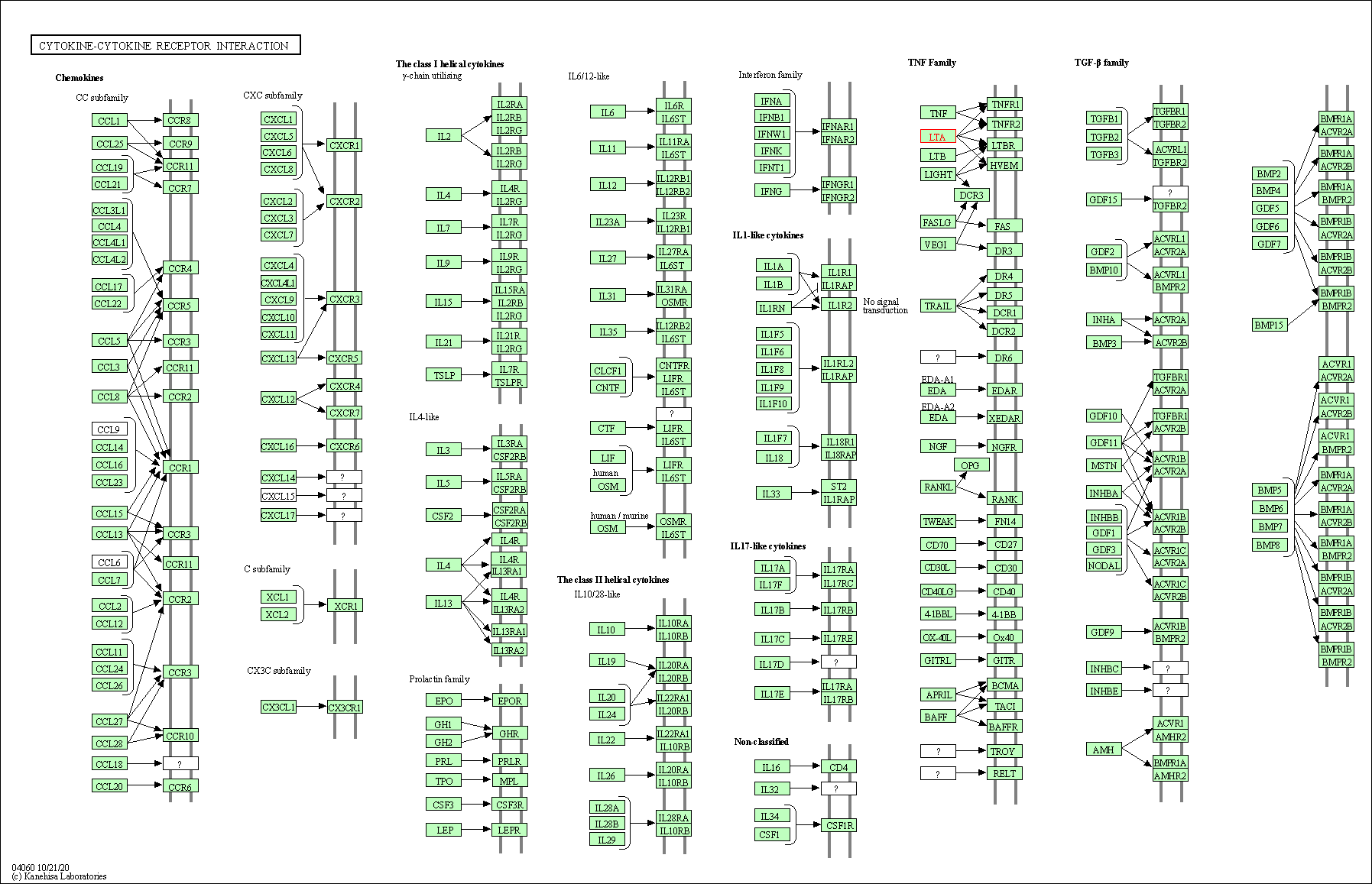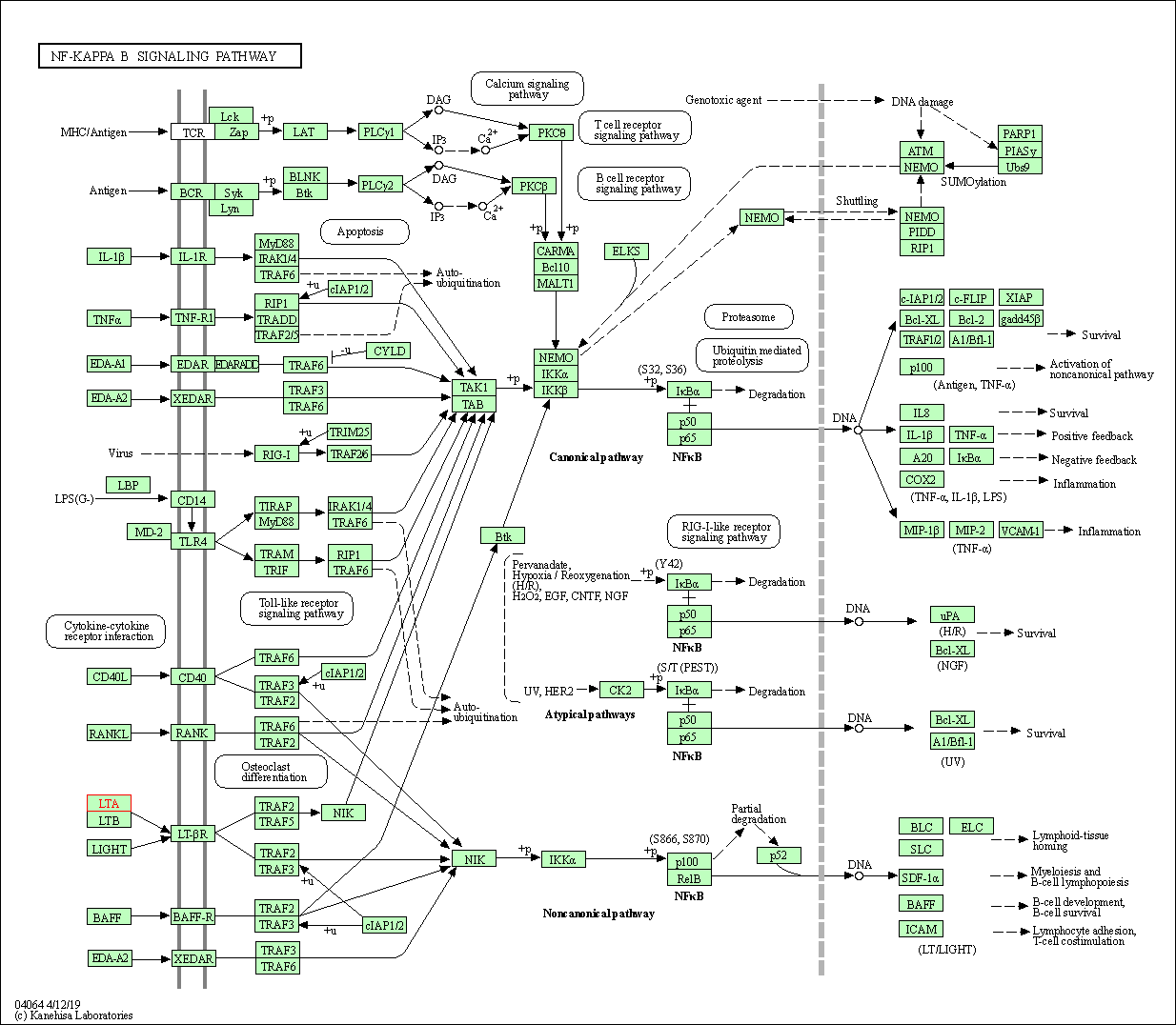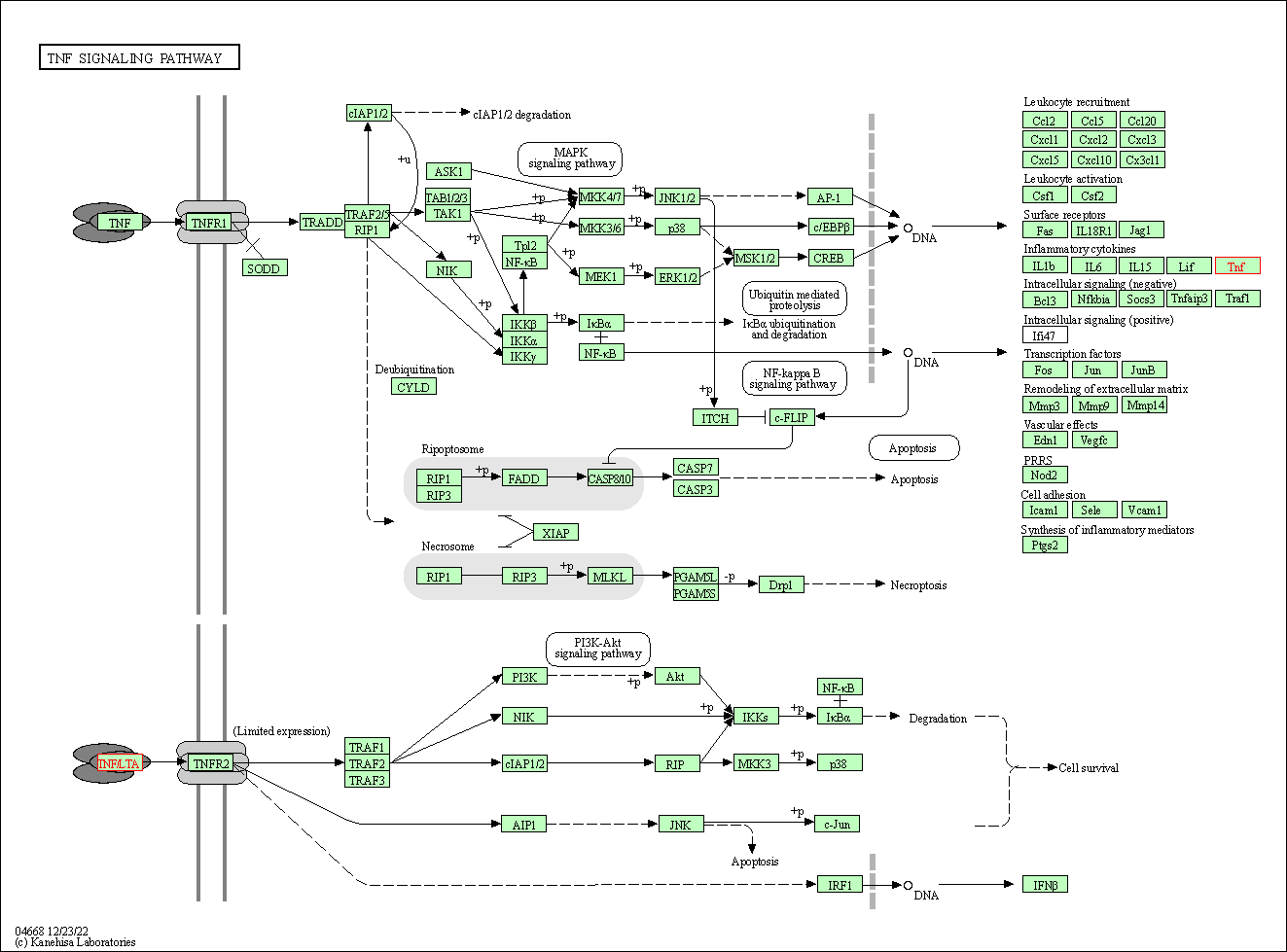Target Information
| Target General Information | Top | |||||
|---|---|---|---|---|---|---|
| Target ID |
T85158
(Former ID: TTDC00327)
|
|||||
| Target Name |
Lymphotoxin-alpha (LTA)
|
|||||
| Synonyms |
Tumor necrosis factor ligand superfamily member 1; TNFSF1; TNFB; TNF-beta; LT-alpha
Click to Show/Hide
|
|||||
| Gene Name |
LTA
|
|||||
| Target Type |
Clinical trial target
|
[1] | ||||
| Disease | [+] 1 Target-related Diseases | + | ||||
| 1 | Rheumatoid arthritis [ICD-11: FA20] | |||||
| Function |
In its heterotrimeric form with LTB binds to TNFRSF3/LTBR. Lymphotoxin is produced by lymphocytes and is cytotoxic for a wide range of tumor cells in vitro and in vivo. Cytokine that in its homotrimeric form binds to TNFRSF1A/TNFR1, TNFRSF1B/TNFBR and TNFRSF14/HVEM.
Click to Show/Hide
|
|||||
| BioChemical Class |
Cytokine: tumor necrosis factor
|
|||||
| UniProt ID | ||||||
| Sequence |
MTPPERLFLPRVCGTTLHLLLLGLLLVLLPGAQGLPGVGLTPSAAQTARQHPKMHLAHST
LKPAAHLIGDPSKQNSLLWRANTDRAFLQDGFSLSNNSLLVPTSGIYFVYSQVVFSGKAY SPKATSSPLYLAHEVQLFSSQYPFHVPLLSSQKMVYPGLQEPWLHSMYHGAAFQLTQGDQ LSTHTDGIPHLVLSPSTVFFGAFAL Click to Show/Hide
|
|||||
| 3D Structure | Click to Show 3D Structure of This Target | AlphaFold | ||||
| HIT2.0 ID | T77INT | |||||
| Drugs and Modes of Action | Top | |||||
|---|---|---|---|---|---|---|
| Clinical Trial Drug(s) | [+] 1 Clinical Trial Drugs | + | ||||
| 1 | Anti-LT alpha | Drug Info | Phase 2 | Rheumatoid arthritis | [1] | |
| Cell-based Target Expression Variations | Top | |||||
|---|---|---|---|---|---|---|
| Cell-based Target Expression Variations | ||||||
| Different Human System Profiles of Target | Top |
|---|---|
|
Human Similarity Proteins
of target is determined by comparing the sequence similarity of all human proteins with the target based on BLAST. The similarity proteins for a target are defined as the proteins with E-value < 0.005 and outside the protein families of the target.
A target that has fewer human similarity proteins outside its family is commonly regarded to possess a greater capacity to avoid undesired interactions and thus increase the possibility of finding successful drugs
(Brief Bioinform, 21: 649-662, 2020).
Human Pathway Affiliation
of target is determined by the life-essential pathways provided on KEGG database. The target-affiliated pathways were defined based on the following two criteria (a) the pathways of the studied target should be life-essential for both healthy individuals and patients, and (b) the studied target should occupy an upstream position in the pathways and therefore had the ability to regulate biological function.
Targets involved in a fewer pathways have greater likelihood to be successfully developed, while those associated with more human pathways increase the chance of undesirable interferences with other human processes
(Pharmacol Rev, 58: 259-279, 2006).
Biological Network Descriptors
of target is determined based on a human protein-protein interactions (PPI) network consisting of 9,309 proteins and 52,713 PPIs, which were with a high confidence score of ≥ 0.95 collected from STRING database.
The network properties of targets based on protein-protein interactions (PPIs) have been widely adopted for the assessment of target’s druggability. Proteins with high node degree tend to have a high impact on network function through multiple interactions, while proteins with high betweenness centrality are regarded to be central for communication in interaction networks and regulate the flow of signaling information
(Front Pharmacol, 9, 1245, 2018;
Curr Opin Struct Biol. 44:134-142, 2017).
Human Similarity Proteins
Human Pathway Affiliation
Biological Network Descriptors
|
|
|
There is no similarity protein (E value < 0.005) for this target
|
| KEGG Pathway | Pathway ID | Affiliated Target | Pathway Map |
|---|---|---|---|
| Cytokine-cytokine receptor interaction | hsa04060 | Affiliated Target |

|
| Class: Environmental Information Processing => Signaling molecules and interaction | Pathway Hierarchy | ||
| Viral protein interaction with cytokine and cytokine receptor | hsa04061 | Affiliated Target |

|
| Class: Environmental Information Processing => Signaling molecules and interaction | Pathway Hierarchy | ||
| NF-kappa B signaling pathway | hsa04064 | Affiliated Target |

|
| Class: Environmental Information Processing => Signal transduction | Pathway Hierarchy | ||
| TNF signaling pathway | hsa04668 | Affiliated Target |

|
| Class: Environmental Information Processing => Signal transduction | Pathway Hierarchy | ||
| Degree | 6 | Degree centrality | 6.45E-04 | Betweenness centrality | 1.22E-04 |
|---|---|---|---|---|---|
| Closeness centrality | 2.04E-01 | Radiality | 1.35E+01 | Clustering coefficient | 2.00E-01 |
| Neighborhood connectivity | 2.17E+01 | Topological coefficient | 2.59E-01 | Eccentricity | 11 |
| Download | Click to Download the Full PPI Network of This Target | ||||
| Target Regulators | Top | |||||
|---|---|---|---|---|---|---|
| Target-interacting Proteins | ||||||
| Target Profiles in Patients | Top | |||||
|---|---|---|---|---|---|---|
| Target Expression Profile (TEP) | ||||||
| Target Affiliated Biological Pathways | Top | |||||
|---|---|---|---|---|---|---|
| KEGG Pathway | [+] 6 KEGG Pathways | + | ||||
| 1 | Cytokine-cytokine receptor interaction | |||||
| 2 | NF-kappa B signaling pathway | |||||
| 3 | TNF signaling pathway | |||||
| 4 | Type I diabetes mellitus | |||||
| 5 | HTLV-I infection | |||||
| 6 | Herpes simplex infection | |||||
| NetPath Pathway | [+] 3 NetPath Pathways | + | ||||
| 1 | TCR Signaling Pathway | |||||
| 2 | IL2 Signaling Pathway | |||||
| 3 | RANKL Signaling Pathway | |||||
| Panther Pathway | [+] 1 Panther Pathways | + | ||||
| 1 | Apoptosis signaling pathway | |||||
| PID Pathway | [+] 2 PID Pathways | + | ||||
| 1 | IL4-mediated signaling events | |||||
| 2 | IL2 signaling events mediated by STAT5 | |||||
| Reactome | [+] 3 Reactome Pathways | + | ||||
| 1 | TNFR2 non-canonical NF-kB pathway | |||||
| 2 | TNFs bind their physiological receptors | |||||
| 3 | TNF receptor superfamily (TNFSF) members mediating non-canonical NF-kB pathway | |||||
| WikiPathways | [+] 1 WikiPathways | + | ||||
| 1 | Apoptosis | |||||
| References | Top | |||||
|---|---|---|---|---|---|---|
| REF 1 | Clinical pipeline report, company report or official report of Genentech (2011). | |||||
If You Find Any Error in Data or Bug in Web Service, Please Kindly Report It to Dr. Zhou and Dr. Zhang.

